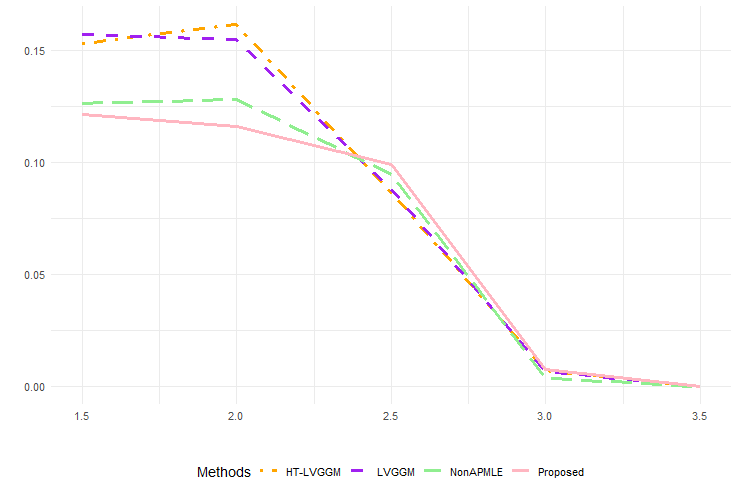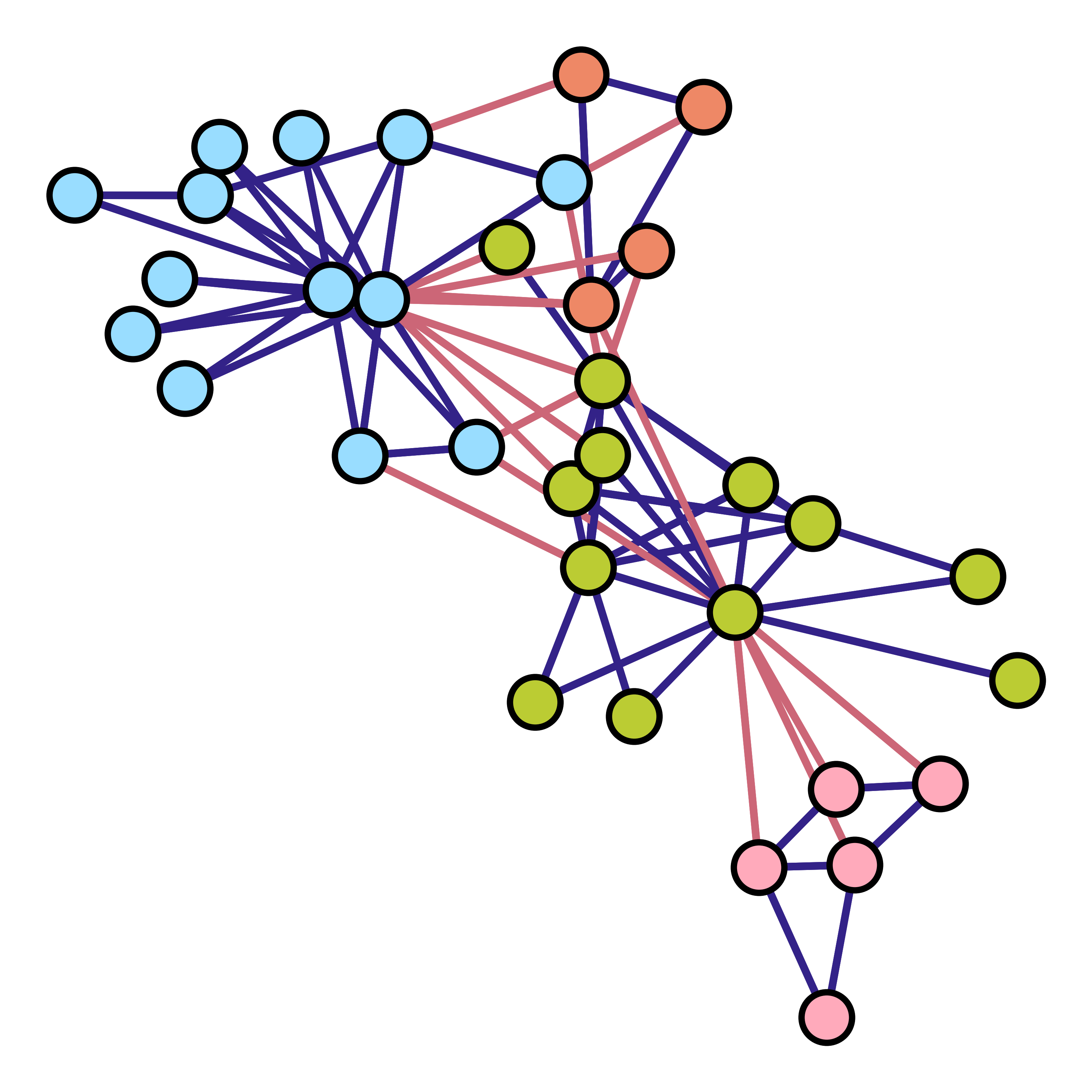Robust Model Selection of Gaussian Graphical Models
2211.05690

0
0
📈
Abstract
In Gaussian graphical model selection, noise-corrupted samples present significant challenges. It is known that even minimal amounts of noise can obscure the underlying structure, leading to fundamental identifiability issues. A recent line of work addressing this robust model selection problem narrows its focus to tree-structured graphical models. Even within this specific class of models, exact structure recovery is shown to be impossible. However, several algorithms have been developed that are known to provably recover the underlying tree-structure up to an (unavoidable) equivalence class. In this paper, we extend these results beyond tree-structured graphs. We first characterize the equivalence class up to which general graphs can be recovered in the presence of noise. Despite the inherent ambiguity (which we prove is unavoidable), the structure that can be recovered reveals local clustering information and global connectivity patterns in the underlying model. Such information is useful in a range of real-world problems, including power grids, social networks, protein-protein interactions, and neural structures. We then propose an algorithm which provably recovers the underlying graph up to the identified ambiguity. We further provide finite sample guarantees in the high-dimensional regime for our algorithm and validate our results through numerical simulations.
Create account to get full access
Overview
- Noise-corrupted data presents significant challenges in Gaussian graphical model selection
- Even small amounts of noise can obscure the underlying structure, leading to identifiability issues
- Recent work has focused on recovering tree-structured graphical models, but exact structure recovery is impossible
- Algorithms have been developed that can recover the underlying tree-structure up to an equivalence class
Plain English Explanation
When working with data that has been corrupted by random noise, it can be very difficult to accurately determine the underlying structure of a Gaussian graphical model. Even a small amount of noise can make it hard to see the true connections between variables. Researchers have found that for a specific type of model called a tree-structured graphical model, it's impossible to recover the exact structure, but there are algorithms that can recover the structure up to a certain level of ambiguity.
In this paper, the authors extend these results to more general types of graphical models, beyond just tree-structured ones. They first characterize the level of ambiguity that is unavoidable when trying to recover the structure of a general graph in the presence of noise. Even though there will always be some uncertainty, the structure that can be recovered still provides useful information about local clustering and global connectivity patterns in the underlying model. This kind of information can be valuable for real-world applications like analyzing power grids, social networks, protein interactions, and neural structures.
The authors then propose a new algorithm that can provably recover the underlying graph structure up to the identified ambiguity, and they provide guarantees about the algorithm's performance even with limited data. They also validate their results through simulations.
Technical Explanation
The authors first characterize the equivalence class up to which general graphs can be recovered in the presence of noise. They prove that exact structure recovery is impossible, but the recovered structure still reveals local clustering information and global connectivity patterns.
The authors then propose an algorithm that can provably recover the underlying graph up to this identified ambiguity. They provide finite sample guarantees for their algorithm in the high-dimensional regime and validate the results through numerical simulations.
The key technical contributions are:
- Characterizing the fundamental limits of graph recovery in the presence of noise, beyond just tree-structured models.
- Proposing a new algorithm that can recover the graph structure up to the identified ambiguity, with provable guarantees.
- Validating the algorithm's performance through simulations.
Critical Analysis
The paper makes important theoretical contributions by characterizing the inherent ambiguity in recovering graph structures from noisy data. This is a significant extension beyond just tree-structured models, which was the focus of prior work.
However, the paper does not address the practical challenges of applying these methods to real-world datasets, which may have additional complexities like missing data, heterogeneous noise, or nonlinear relationships. Further research is needed to understand how these methods perform in more realistic settings.
Additionally, the paper focuses on Gaussian graphical models, but many real-world networks, such as social networks or biological networks, may have non-Gaussian or more complex underlying structures. Extending these techniques to a broader class of graphical models could be an important area for future work.
Overall, the paper makes a valuable theoretical contribution, but additional research is needed to understand the practical applicability and limitations of the proposed methods.
Conclusion
This paper addresses the challenge of recovering the structure of Gaussian graphical models when the data is corrupted by noise. The authors show that while exact structure recovery is impossible, the structure that can be recovered still provides useful information about local clustering and global connectivity patterns.
The authors propose a new algorithm that can provably recover the underlying graph structure up to an identified ambiguity, and they provide finite sample guarantees for the algorithm's performance. This work extends prior results beyond just tree-structured models, making important theoretical advances in the field of robust graphical model selection.
While the paper focuses on the theoretical aspects, the insights and techniques developed could have significant practical implications for a wide range of applications, from power grid analysis to social network modeling to understanding biological systems. Further research is needed to explore the real-world applicability of these methods and address additional complexities that may arise in practice.
This summary was produced with help from an AI and may contain inaccuracies - check out the links to read the original source documents!
Related Papers

Simultaneous Identification of Sparse Structures and Communities in Heterogeneous Graphical Models
Dapeng Shi, Tiandong Wang, Zhiliang Ying

0
0
Exploring and detecting community structures hold significant importance in genetics, social sciences, neuroscience, and finance. Especially in graphical models, community detection can encourage the exploration of sets of variables with group-like properties. In this paper, within the framework of Gaussian graphical models, we introduce a novel decomposition of the underlying graphical structure into a sparse part and low-rank diagonal blocks (non-overlapped communities). We illustrate the significance of this decomposition through two modeling perspectives and propose a three-stage estimation procedure with a fast and efficient algorithm for the identification of the sparse structure and communities. Also on the theoretical front, we establish conditions for local identifiability and extend the traditional irrepresentability condition to an adaptive form by constructing an effective norm, which ensures the consistency of model selection for the adaptive $ell_1$ penalized estimator in the second stage. Moreover, we also provide the clustering error bound for the K-means procedure in the third stage. Extensive numerical experiments are conducted to demonstrate the superiority of the proposed method over existing approaches in estimating graph structures. Furthermore, we apply our method to the stock return data, revealing its capability to accurately identify non-overlapped community structures.
5/17/2024

Fair GLASSO: Estimating Fair Graphical Models with Unbiased Statistical Behavior
Madeline Navarro, Samuel Rey, Andrei Buciulea, Antonio G. Marques, Santiago Segarra

0
0
We propose estimating Gaussian graphical models (GGMs) that are fair with respect to sensitive nodal attributes. Many real-world models exhibit unfair discriminatory behavior due to biases in data. Such discrimination is known to be exacerbated when data is equipped with pairwise relationships encoded in a graph. Additionally, the effect of biased data on graphical models is largely underexplored. We thus introduce fairness for graphical models in the form of two bias metrics to promote balance in statistical similarities across nodal groups with different sensitive attributes. Leveraging these metrics, we present Fair GLASSO, a regularized graphical lasso approach to obtain sparse Gaussian precision matrices with unbiased statistical dependencies across groups. We also propose an efficient proximal gradient algorithm to obtain the estimates. Theoretically, we express the tradeoff between fair and accurate estimated precision matrices. Critically, this includes demonstrating when accuracy can be preserved in the presence of a fairness regularizer. On top of this, we study the complexity of Fair GLASSO and demonstrate that our algorithm enjoys a fast convergence rate. Our empirical validation includes synthetic and real-world simulations that illustrate the value and effectiveness of our proposed optimization problem and iterative algorithm.
6/17/2024
👀
Almost exact recovery in noisy semi-supervised learning
Konstantin Avrachenkov, Maximilien Dreveton

0
0
Graph-based semi-supervised learning methods combine the graph structure and labeled data to classify unlabeled data. In this work, we study the effect of a noisy oracle on classification. In particular, we derive the Maximum A Posteriori (MAP) estimator for clustering a Degree Corrected Stochastic Block Model (DC-SBM) when a noisy oracle reveals a fraction of the labels. We then propose an algorithm derived from a continuous relaxation of the MAP, and we establish its consistency. Numerical experiments show that our approach achieves promising performance on synthetic and real data sets, even in the case of very noisy labeled data.
6/6/2024
📊
Exploration of the search space of Gaussian graphical models for paired data
Alberto Roverato, Dung Ngoc Nguyen

0
0
We consider the problem of learning a Gaussian graphical model in the case where the observations come from two dependent groups sharing the same variables. We focus on a family of coloured Gaussian graphical models specifically suited for the paired data problem. Commonly, graphical models are ordered by the submodel relationship so that the search space is a lattice, called the model inclusion lattice. We introduce a novel order between models, named the twin order. We show that, embedded with this order, the model space is a lattice that, unlike the model inclusion lattice, is distributive. Furthermore, we provide the relevant rules for the computation of the neighbours of a model. The latter are more efficient than the same operations in the model inclusion lattice, and are then exploited to achieve a more efficient exploration of the search space. These results can be applied to improve the efficiency of both greedy and Bayesian model search procedures. Here we implement a stepwise backward elimination procedure and evaluate its performance by means of simulations. Finally, the procedure is applied to learn a brain network from fMRI data where the two groups correspond to the left and right hemispheres, respectively.
4/16/2024